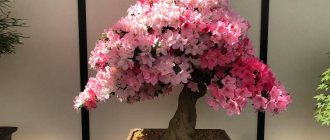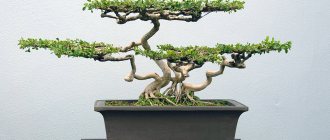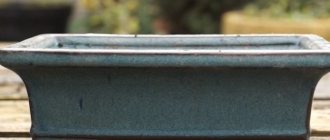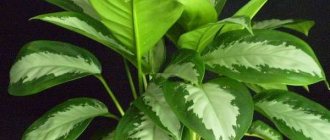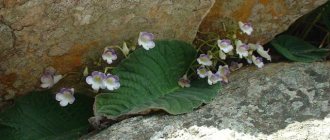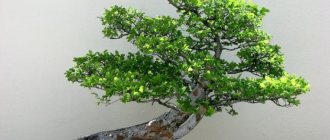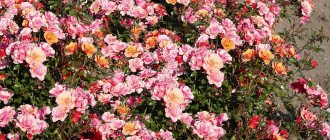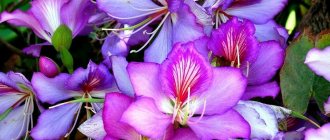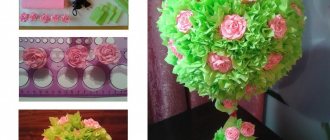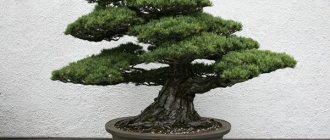Bonsai is a gardening art whose purpose is to grow a decorative miniature tree. Imagine pine, cedar or maple growing in a small pot on the windowsill!
The hundred year old maple and scarlet begonias look amazing!
This art appeared in Japan more than 2 thousand years ago, then migrated to China, and about a century ago it became popular throughout the world. Let's talk about how to grow bonsai, how to choose a plant, soil, pot, how to form a crown, etc.
How to choose a plant for bonsai
You can grow bonsai of any type: all deciduous and coniferous trees, flowering or decorative deciduous. Any of them will (and should) repeat the natural cycle. The best choice is plants with small leaves and a lot of branches.
Typically, a bonsai tree is no more than half a meter in height. And superminiature ones can be up to 3 cm. Huge bonsai are only 150 cm and no more
There are specific species recommended for bonsai:
- Japanese quince, wild, Chinese;
- hawthorn;
- small-leaved elm, squat;
- Canadian spruce, common;
- common larch;
- Chinese juniper;
- aspen;
- ficuses (almost all, but the best is Benjamina);
- small-fruited apple tree (may have red or green leaves), wild;
You can keep bonsai both in the house and in the garden. Choose a location for each individual. It is not recommended to change it.
Every season has its own charm
Please note that deciduous plants will change color and shed leaves in the fall, and bud and bloom in the spring. If you don't want to see bare branches in winter, choose something evergreen. For example, conifers or other evergreen species.
For beginners, the best choice is ficus benjamina. It grows quickly, has small shiny leaves and a trunk that thickens on its own. Already at 5 years it will look like an old tree.
Form your first bonsai from ficus benjamina
At the same time, you can try to grow a coniferous or deciduous seedling. At the same time you will understand the difference.
Choosing the right tree for bonsai
What types of plants are suitable for bonsai, Japanese style tree? To quickly get an attractive tree, you can pay attention to:
- for indoor varieties of citrus fruits, for example, calamondin or regular lemon;
- for dwarf pomegranate;
- to the incredibly common and unpretentious Ficus Benjamin;
- for decorative varieties of apple trees;
- on the willow;
- on low-growing pines;
- for a wide variety of maple species.
The choice of trees suitable for bonsai is incredibly large, and many of them are indigenous to Russia and are found in gardens, parks, city squares and forests. Magnificent compositions are obtained from barberry and serviceberry, hawthorn, acacia and birch, elderberry and linden, euonymus and oak.
Before growing a bonsai, based on the type of plant, its future height and style are determined.
Bonsai styles
This art is more than two thousand years old, so there are more than two dozen main styles alone. The very first thing to do is to choose the style in which you will form your miniature tree.
Basic Bonsai Tree Styles
Please note that styles differ not only in the presence or absence of a slope, the number of trunks, but also in the location of the main branches. If you like a particular style, find its detailed description and several photographs. All this will be required when forming the trunk and crown.
And these are not the smallest ones
There is also a division of bonsai trees by size. There are five main classes, and three of them also have gradations. The sizes of bonsai trees are shown in the table below. There are also Russified analogues of Japanese/Chinese names.
| Class | Subclass | Bonsai tree height | Russian name | Bonsai Pot Dimensions |
| Mame | Keshi-Tsubu | less than 2.5 cm | Tiny | 3-8 cm |
| Sieve | from 2.5 cm to 7.5 cm | 5-10 cm | ||
| Gafu | from 8 cm to 3 cm | 10-15 cm | ||
| Sehin | Komono | from 13 cm to 17 cm | Small | 12-20 cm |
| Myabi | from 18 cm to 25 cm | 15-25 cm | ||
| Kifu | Katade Mochi | up to 40 cm | Average | 25-46 cm |
| Tyu/Tyukhin | Katade Mochi | from 40 cm to 60 cm | Big | 40-90 cm |
| Omono | from 60 cm to 120 cm | |||
| Dai/Daiza | Bonju | more than a meter | Huge | 75-125 cm |
Alarming symptoms
You can understand that a bonsai tree needs moisture by the following signs:
- The plant does not grow, looks lethargic, and the shoots weaken.
- The root system grows greatly and constantly reaches the surface in search of moisture.
- The foliage withers, turns pale, turns yellow, and falls off.
- The dry earthen lump is very hard and cracked.
In addition to moisture deficiency, an excess of moisture is no less dangerous for a plant, the signs of which are:
- Slowing down or completely stopping growth.
- The foliage begins to darken and fall off greatly.
- The substrate has an unpleasant odor and harmful insects appear.
- The root system begins to rot, as a result of which the plant itself withers, the trunk wrinkles and becomes soft.
Timely care of bonsai trees will allow you to grow a strong, healthy plant that will become a bright decoration of any modern interior.
Techniques (methods) for growing them
Next, we decide on the start. There are three techniques for growing bonsai trees:
- from seeds (it will take 12-15 years to form a bonsai-like plant);
- from seedlings (minimum period - 5-7 years);
- cuttings (some species will look like bonsai after 4-5 years).
Advice for beginners: form one or two seedlings, and grow another ten, twenty or thirty.
With any growing method, the plant in the “starter” pot is grown to the desired height. The formation of the crown and bending of the trunk occurs while the “blank” is growing. A ready-made mini-tree that has finished growing is transferred to an “adult” pot.
What to do with the seeds
If you decide to germinate from seeds, place them in a container with moss for the cold season and place them on the bottom shelf in the refrigerator. Until spring. Cold temperatures prepare the seed to grow as the weather warms. This process is called stratification. In the spring, plant the seeds in the ground, keep the soil slightly moist, but do not let it sour. Sprouts will quickly appear and immediately begin to grow.
Seeds can be germinated in egg trays
Stratification is necessary for plants in our climate zone. Germinate tropical tree seeds after soaking them in water for 24 hours.
The hatched seeds are watered and left to grow. When they are more than 10 cm high, you can transfer each one to its own pot, wait a couple of months until they take root, and begin formation.
Choosing seedlings
Grow a bonsai from a seedling faster. They are planted in the fall. It will be much easier if you buy a selected and prepared plant in a specialized store or garden center.
In general, seedlings can be found in the forest, but it is better on a roof, on a rock or a fence. Where there is not enough soil. The plant should be no more than 15-20 cm high. It is desirable that it already has enough lateral branches.
Seedlings can be bought at a specialty store or found in the forest. To make it clearer what to choose, the right one at the plate is simply perfect. Cut off the excess during the formation process and get a decorative crown
If you dig, grab some of the “native” soil - adaptation will be easier. Allow the plant to take root in the pot until spring.
Bonsai cuttings
You will have to take cuttings for exotic plants such as ficus, figs, tea tree, etc. They are cut off in the spring from mature plants (before young buds appear) from the trunk itself. The length of the cutting is about 25 cm. Ideally, there should be several side branches. We cut off the upper, too soft part of the cutting parallel to the ground. We also cut off the lower one, which is too hard, but at an angle. We remove the lower leaves; if there are large ones, cut off most of them, leaving half a leaf.
Cuttings must be strong
Dip the bottom cut into the rooting agent.
Phytoclon - an effective gel for rooting plant cuttings
The cuttings can be kept in water until roots appear or immediately planted in a clay pot (regular) with ordinary garden soil. The cut should be deepened by 5-7 cm. Place the pot/jar with cuttings in the shade and water regularly. When new leaves appear, gradually move the pot to a more illuminated place, but not into open sun. Feed once a month. Grow the seedling for a year or two until it reaches the desired height.
II. Specific means
Healing paste
Healing paste is one of the most basic tools of any bonsai owner and should be kept on hand by everyone. This paste, like a band-aid, is designed to be applied to newly trimmed areas. It promotes healing by protecting the wound from damage.
Shin-Kiyonaal
Shin-Kiyonaal is a specialized healing paste designed for large cuts, such as after pruning a large branch, or when attempting to graft. In addition to its protective properties, it contains a number of insecticides and fungicides that ensure that the cut does not become infected during the long healing period.
Lime sulfur
Jin Seal products are specifically designed to preserve dead wood on wood to make it look older and more worn. This mixture preserves and discolors dead wood, preventing damage to the living parts of the tree, making the dead areas more visible. But be careful - when working, use eye and hand protection, as these substances are very caustic, follow all the rules specified in the instructions on the package.
Root gel
Dyna-Grow Gel is designed for those trying to transplant tree cuttings.
By covering the cutting with a protective gel full of nutrients, we replace its roots until it begins to grow on its own. The gel ensures the safety of the cutting during the most vulnerable period and significantly increases the chances of its further growth. Are you facing a more specific problem? Check out care guides for more information about your tree, or simply contact the experts for more information!
Bonsai pot
If you look at different photos, all mini-trees grow in wide and flat pots. And this is no coincidence. It is by limiting the growth of the root system in depth that the growth of the above-ground part is inhibited. You need to find such a bowl - wide, with low sides. The best one is ceramic. Ideally, in general, stone. Approximate pot sizes for each class of bonsai tree are given in the table above.
Plant seedlings in wide and flat pots and bowls
A bonsai pot should have several drainage holes. Ideally, they are located two on each side. A wire is threaded through them, which is used to fasten the plant.
Please note that when transplanting, the pot is not changed. When growing (accelerating), a “starter” pot is used. This is still not a bonsai, but only a preparation for it. The mini-tree will spend the rest of its life in the same pot.
Preparing a Bonsai Pot
Since there is little space for the root system, the roots grow into holes for water drainage. To prevent this from becoming a problem, secure a piece of garden net over the hole. It can be glued with silicone or fixed with a piece of wire, as shown in the photo above.
Fertilizers
Trees are usually planted in small pots, so bonsai are in greater need of feeding. Potassium, nitrogen and phosphorus fertilizers are well suited for the plant - they are responsible for the green color of the leaves, the development of roots and the appearance of flowers. Moreover, you need to care for your bonsai with fertilizers regularly at least 3-5 times throughout the year.
Don't forget about the appearance of the bonsai! The tree takes on new beautiful shapes with proper pruning of branches and shoots. It is better to remove excess branches in the spring and only with sharp tools, so as not to accidentally harm the plant. As a sign of gratitude for your careful care, the bonsai will decorate your home and fill it with a lemon-pine aroma for many years.
Text:
The soil
You will have to prepare the soil for growing a bonsai tree yourself. The recipe depends on the type of plant. For tropical species, take the following composition:
- river sand (coarse) - 40%;
- garden soil - 30%;
- organic fertilizer - 20%;
- crushed peat - 10%.
Soil is important for normal growth.
For plants in our climate zone , we take 3 parts of garden soil, 1 part each of sand and peat. These are approximate proportions that can be adjusted. For example, for those plants that grow best in sandy soils, use more sand than garden soil.
Suitable options
You can form a small bonsai tree from a wide variety of plants. Most suitable for work:
- Coniferous species such as pine, larch, juniper, spruce, etc.
- Deciduous options: apple tree, azalea, sakura, maple, beech, hornbeam, etc.
- Evergreen forms such as hibiscus, ficus, olive, syzygium, etc.
In addition, you can often find unique mixed bonsai compositions consisting of trees of various species. It is the plant variety that is the fundamental guideline in choosing care conditions.
Bending and shaping
To give the tree the desired shape or slope, use thick aluminum or copper wire. It is wound around the trunk and branches. All that exist at the moment or only those that need to be “moved” or bent.
One of the techniques for forming a bonsai tree. This birch is one of the most flexible plants
They usually start from the trunk. They start from the roots, moving to the top. Then they move on to the branches. If you don't want wire marks left, don't wrap it too tightly. Once the wire is in place, slowly and smoothly bend the plant into the desired shape. Sometimes, to hold the barrel, you have to wind a double helix.
For beginners, the best tactic is to choose a sample and strive to repeat it
Bend coniferous plants especially carefully. For them, it is necessary to begin formation already in the first/second year. Therefore, take young seedlings or two-year-old cuttings. When growing bonsai from spruce, cedar, larch and pine, shape the branches immediately after the growth of young shoots stops. Partially cut them off, wrap the remainder with wire and direct them in the desired direction.
The wire is removed only after the trunk and branches have completely hardened and taken the desired shape
With wire you keep plants for six months or more. At this time, water it regularly and feed it with fertilizers for the species being grown. Then you can remove the wire and transfer the plant to the “main” pot.
Light
The tree needs 6 hours of sunlight every day. If the plant is in a dark place, then the lighting should be increased to 12 hours a day. Do not overdo it with electric light - the plant may be damaged. It is clear that in our climate it is difficult to care for bonsai, providing many hours of natural light. Especially when it's winter or autumn outside. However, try to move the tree during the day, maybe move it to another room, to provide the plant with the highest possible level of light and comfort.
Trimming
Pruning a bonsai tree is an ongoing process. The primary is done before applying the wire. Cut off all unnecessary branches, wait until the cuts are healed (the juice will stop secreting and the bark will grow). Now you can wind the wire. In the future, with the help of pruning, you maintain the crown of the required shape and size, cutting off everything unnecessary. During the growing season, you may need to cut off the excess once a month.
To prevent infection when cutting branches, use sterilized pruners or scissors. Lubricate the cut area with a garden fungicide to prevent rotting.
Crown formation is a constant process. It allows you to maintain the desired plant height. And it is not necessary to remove dried branches. They give a special flavor
When pruning, keep a picture in your mind (or in front of you) of what you want to achieve. And form the crown exactly the way you want to see. You can trim either at the base (be it a trunk or a larger branch), or leaving a “stump” of several buds.
Caring for a bonsai tree at home
It is not enough to purchase a miniature tree, get a young seedling, or root a cutting of the species you like. It is important to know how to care for a bonsai tree.
By constantly limiting growth, shaping the crown and growing a bonsai in a small pot, a person completely changes the life of a tree or shrub. Therefore, caring for such a crop is very different from caring for other indoor plants.
The main task of the gardener is to organize watering of the bonsai, which is not easy to cope with with a small volume of soil and a shallow pot filled with roots.
Previously, gardeners only had a specially shaped watering can or the ability to immerse a bonsai pot in a bowl of water to wet the soil from below. Today, plant irrigation or drip irrigation is actively used, which allows the soil under bonsai to be moistened in doses and without the risk of erosion.
For irrigation, use only soft, melted or settled water. During the growing season, plants need more moisture; with the onset of autumn and the approach of the dormant period, watering is reduced and carried out less frequently, focusing on the condition of the substrate.
Fertilizing is carried out at intervals of 2–3 weeks, using their own mixtures for different crops and seasons. For Japanese bonsai trees, there are mineral fertilizers based on algae.
You can’t leave plants without food, but it’s equally important not to overfeed your bonsai. Therefore, when caring for bonsai trees at home, fertilizing is done very carefully:
- in the spring, at maximum growth intensity, include twice as much nitrogen in the fertilizer as potassium and phosphorus;
- in summer the proportions remain the same, but the concentration is halved;
- closer to autumn, especially for deciduous crops, the content of potassium and phosphorus is doubled, and nitrogen, on the contrary, is reduced.
- Flowering and fruit-bearing trees and shrubs need more potassium, which is used for the formation of buds and ovaries.
With the arrival of winter, nothing changes for exotic evergreens, but coniferous and deciduous trees must prepare for winter. How to care for a bonsai tree in winter? If the climate allows, they are left outside or brought onto unheated terraces. The root system in a small bonsai pot may be the first to suffer, so it is additionally covered and the soil is dried a little. With the onset of spring, the plant awakens and again needs watering, fertilizing and the formation of the crown and roots, which is mandatory for bonsai.
How to grow bonsai - video
Transplantation: rules, root pruning, pot preparation
Bonsai replanting is needed to replace depleted soil and trim roots, remove rotten and diseased fragments. It is required once every 2-3 years. In this case, we change the pot only once - when we transfer the tree from the “children’s” pot to a permanent one. It will not be changed in the future.
When transplanting, the pot is washed inside and disinfected. It is heated to 90-95°C with boiled water, changing it several times. To keep a tree with rhizomes almost flat in shape, wire is threaded through the holes to drain excess moisture. It will also hold the mesh.
Trimming roots when replanting and preparing the pot
Take out the plant, shake off the soil and trim the roots. When transplanting from a children's pot, remove up to 2/3 of the roots. Cut off those that point downwards, leaving those running horizontally. An example of such root pruning is shown in the figure above.
If the root system looks more like a sponge and there is no way to isolate the roots, take a thin wooden stick (skewer) and pierce the lump from top to bottom. In this case, part of the roots breaks off, while others straighten. When you can already understand what is where, you pull it out with your fingers and start trimming.
When replanting a bonsai, cut off the roots and change the soil, but not the pot.
Place the prepared plant in a pot, thread a wire through the roots and secure the bonsai. Fill 3/4 of the pot volume with the prepared soil mixture. After transplanting, keep it in the shade for a couple of weeks, water regularly, but make sure that the soil does not become acidic. Gradually move the pot to the place where it should be.
This is a short guide to growing bonsai. A formed plant requires feeding and care that this species needs. The difference from their “ordinary” counterparts is pruning and replanting.
Lighting and watering
Most plants cultivated in the art of bonsai grow in the open air, so the trees themselves should be kept in well-lit places , shaded only from direct sunlight.
In winter, when the sun is not so active, fluorescent lamps are used If there is insufficient lighting, the tree stretches upward (and this is not at all necessary for bonsai), the leaves become larger, and the branches stop growing. Light is especially important for fruit-bearing trees.
The root system of bonsai needs intensive and proper watering, without drying out the earthen coma. In summer, plants need constant moisture, especially deciduous ones, and to a lesser extent evergreens and conifers. In winter, the opposite is true—conifers have an increased need for moisture.
Watering is carried out using a container with water. The bonsai is briefly immersed in the container so that the water covers the ground and the soil ball is saturated with water. Spraying is also done regularly, this is especially important for deciduous plants.
